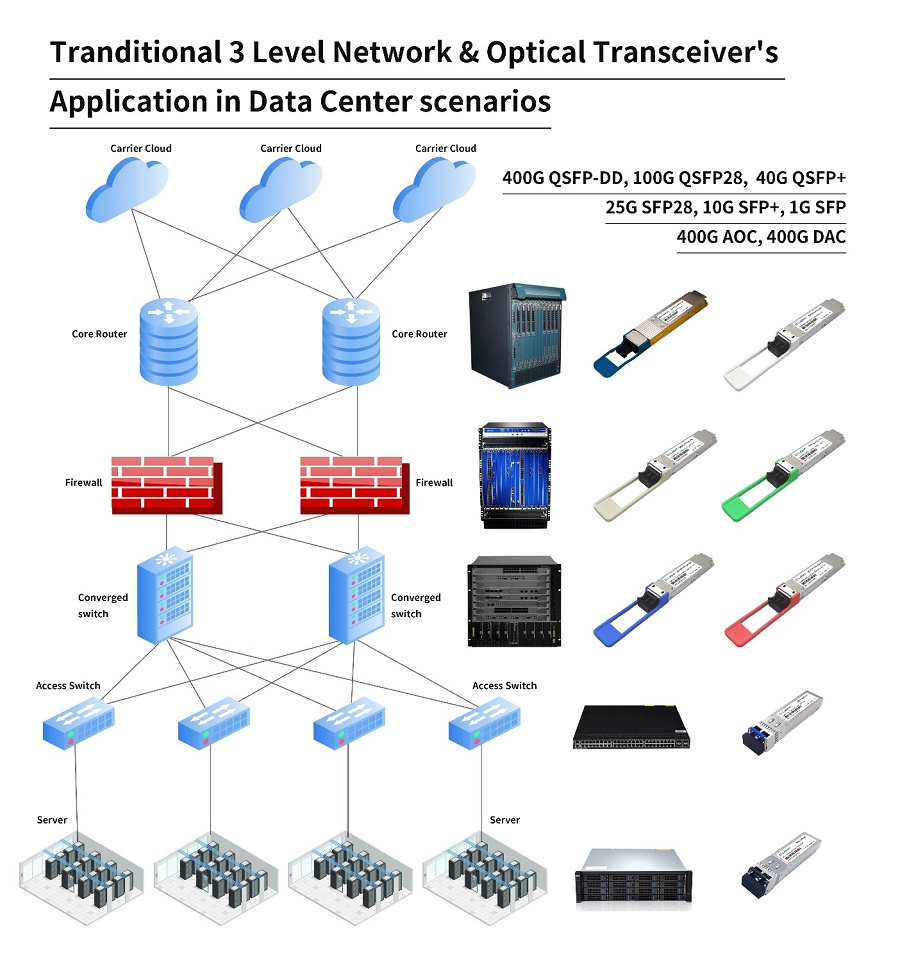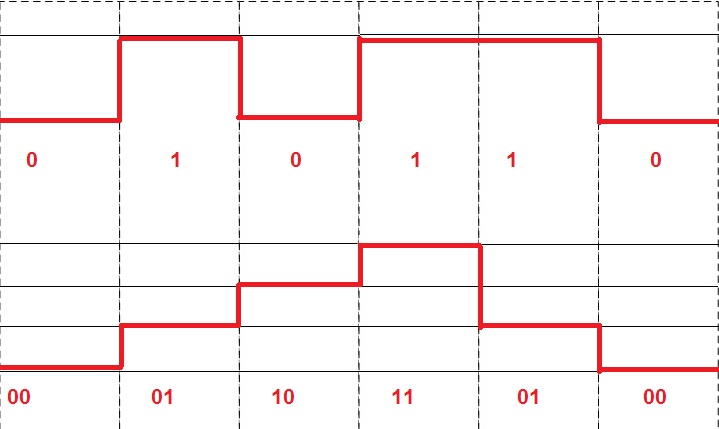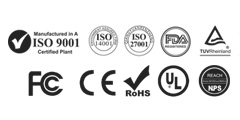 Phone number:+86 136 3169 4925
Phone number:+86 136 3169 4925 Industrial campus 25G/100G three-layer Ethernet Optical module applications
Posted on:September 1, 2024 by C-LIGHT
In 2023, with the popularity of Wi-Fi 6 and the emergence of new application needs such as enterprise cloud implementation, current 10g/40g uplink bandwidth from the access layer to the convergence layer of industrial campus network can no longer meet customer needs. As a high-bandwidth, high-density and low-cost solution, the 25g/100g upgrade solution promotes the upgrade of campus network applications. The demand for C-Light 25g/100g optical modules is also emerging.
Advantages of 25G/100G network solution
In the process of upgrading the campus network, the following aspects are mainly examined
●Sustainability
When selecting switches and optical modules, it is necessary to reserve space for future continuous upgrades in technology and implementation environments.
●Compatibility
The selected switch brand interfaces must be interoperable. C-LIGHT's optical modules excel in multi-brand interoperability and interface compatibility.
●Energy consumption and cost
Balance and control between high-port-density devices and low-dissipation optical modules and switch brands.
The 25G/100G solution has advantages of low upgrade cost, low energy consumption, more market choices of 10G to 25G and 40G to 100G adaptive switches. C-Light Network 25G 100G transceivers take advantages of complete variety and good compatibility, become the mainstream transceiver products for this upgrade solution.

C-LIGHT's 25G 100G optical module product advantages
●Can effectively utilize existing optical fibers
Compared with 10G 40G optical module products, the product's optical fiber interface, wavelength, and transmission distance have no major changes or shortcomings. This effectively avoids the reconstruction and new construction of existing optical fiber networks during upgrade implementation, thereby reducing optical fiber costs.
●Complete range of products
Both 25G and 100G product series can meet the transmission requirements of dual-fiber or single-fiber bidirectional 100m, 500m, 2km, 10km, 20km, 40km, and 80km.
●Low energy consumption
Compared with 10G 40G optical modules, the energy consumption of 25G SFP28 optical modules and 100G QSFP28 optical modules does not increase much, but the bandwidth is effectively improved.
●Excellent compatibility
The 25G SFP28 optical module and the 100G QSFP28 optical module are designed to be compatible with a wide range of switch brands within existing networks, thereby minimizing switch waste.
Table 1 C-Light transceivers reach distance
Fiber type | 10G optical module | 25G optical module | 40G optical module | 100G optical module |
9µm Single-mode Fiber (LC interface) | 100m~120km | 100m~80km | 100m~80km | 100m~100km |
62.5µm OM3 Multimode fiber (LC interface)) | 100m | 100m | ||
50µm OM4 Multimode Fiber (LC interface) | 300m | 300m | 400m | 100m |
50µm OM4 Multimode Fiber (MPO interface) | - | - | 400m | 300m |
Table 2 Comparison of the power consumption of the C-Light 10G/25G /40G/100G optical modules
(The 10km optical module is used as an example)
Item | 10G optical module | 25G optical module | 40G optical module | 100G optical module |
Passage | 1*10G | 1*25G | 4*10G | 4*25G |
Power | 1W | 1.5W | 3.5W | 3.5W |
C-LIGHT's 25G 100G optical module product technical features:
●Compliance with Technical Standard Agreement
Communication compliant with IEEE 802.3bm, IEEE 802.3bj, IEEE 802.3cc, IEEE 802.3cu;
Interface protocol conforms to SFF-8636, SFF-8665, SFF-8402, SFF-8432 and SFF-8472;
Encapsulation protocol compliant with QSFP28 MSA, SFP28 MSA.
●Support HOST FEC technology and SOA technology
FEC (Forward Error Correction) technology is defined in the IEEE RS-FEC 802.3 bj-2014 standard. It attaches error correction information to the data message at the data sending end, The receiving end uses the error correction information to correct the error code generated in the transmission process of the data message. This technology can effectively reduce the channel error rate and improve the signal quality, thus extending the maximum transmission distance of the physical medium. But also introduce some transmission delay. For example, the 25G SFP28 80km product of the optical network has achieved long-distance transmission with the support of FEC technology.
SOA (Semiconductor Optical Amplifier) technology is a technology that uses semiconductor chips to amplify the power of lasers of specific wavelengths. Due to its small size and low energy consumption, it is conducive to the implementation of pre- or post-amplification functions inside the optical module laser. It is now used in the design and application of high-speed and long-distance optical modules in optical networks. For example, C-LIGHT's 100G QSFP28 XZR 100km product has achieved ultra-long-distance transmission with the support of SOA and FEC technologies.
●Supports TX RX Dual CDR technology
CDR (Clock and Data Recovery) technology refers to recovering the clock information from the received serial data and using the clock information to resample the data signal to obtain stable and reliable data. This technology can reduce the impact of external interference on the data, reduce the phase error of the signal, and improve the quality of the received signal. It can also reduce the requirements of the transmission system for wiring and increase the port density. All 25G and 100G optical modules of C-LIGHT use TX RX dual CDR technology to ensure product performance improvement.

Figure 2 Schematic diagram of CDR principle
Some 100G QSFP28 products have adopted PAM4 technology
PAM4 (4-level Pulse Amplitude Modulation) uses four different signal levels of 00/01/10/11 to transmit data, and can represent 2 bits of logical information in each symbol period. Therefore, if the same signal is to be transmitted, the baud rate of data modulated by PAM4 is only half of that of NRZ. This technology improves the efficiency of the optical module laser and effectively increases the communication rate. C-LIGHT's 100G QSFP28 single lamda LR1 10km optical module has applied PAM4 technology.
Figure 3 NRZ and PAM4 level comparison

Appendix 1 C-LIGHT's 100G QSFP28 100km dual-fiber and 80km single-fiber products

Appendix 2 C-LIGHT's 25G SFP28 industrial application products



























